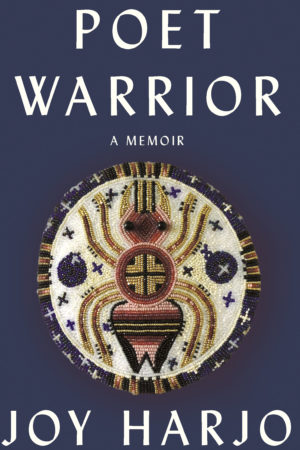Poet Warrior
by Joy Harjo
reviewed by Paul Kaplan
Native American poetry has often been unjustly overlooked by academics, publishers, and readers. With more than 570 official Native nations in the United States alone, Indigenous poetries are diverse as each Native language and culture, yet precious little has been written on either the influences or backstories of most Native American poets.
Joy Harjo’s new memoir Poet Warrior helps to remedy this disparity. Harjo, a member of the Muscogee (Creek) Nation, is the first Native American Poet Laureate and among the first to be appointed to multiple terms. The author of many poetry collections as well as six albums, Harjo also promotes the work of other Native poets. In Living Nations, Living Words, Harjo maps the United States through the poems of forty-seven contemporary Native Nations poets, describing the importance of poetry to understanding people’s lived experience thus:
We understand poetry to be a living language—whether it is in our tribal languages, or in English, or another language. We use poetry to mark transformations, as in love letters, elegies, or epithalamium. Poetry can be useful for praise and even to help deter a storm. Or poetry is a tool to uncover the miraculous in the ordinary.
This understanding of poetry informs Poet Warrior, where Harjo lyrically describes her upbringing in the Muscogee (Creek) Nation in Southeastern Oklahoma through stories about her ancestors, family, and community elders. Harjo’s narrative interfuses prose with poems, songs, chants, and photos to trace her development from “Girl Warrior” into “Poet Warrior.” She presents her story in roughly chronological order while allowing the narrative to jump around. “Life never goes in a straight line in our Native communities,” she explains. “Time moves slower.”
At its best, Poet Warrior elucidates the hidden meaning behind everyday events. On a drive in Northern California, a white owl swoops down against Harjo’s windshield. “Birds are messengers,” she writes. “The owl gives very distinct messages, often about transformations in our lives. They do not necessarily mean death. They represent spiritual power. Power can be dangerous. Power can give or take life.” At the same time, she explains elsewhere that the true significance behind life events “is not always meant for us to know.”
Harjo poignantly describes growing up in poverty with a mother who had only an eighth-grade education and a father who drank heavily. Nevertheless, she reflects on the wisdom she has received from each of them. She effectively ties her own family story to the larger story of her people—particularly the theft of their ancestral land. Harjo’s great-grandfather was born just after the United States government removed her community from their ancestral land and forced them to resettle in what was then called Indian Territory—incidents that ultimately prepared her to become a “poet warrior.”
Harjo also pays homage to her poetic influences. During her first encounter with an Emily Dickinson poem, she writes, “[Dickinson’s] voice reached out from the pages and made friends with me. I could hear her, though we were years, miles, landscapes, and cultures away from each other.” Elsewhere, Harjo confesses that she would never have become a poet if she “hadn’t listened to that small, inner voice that told me poetry was the path, even when I had different plans.” Simon Ortiz, Acoma poet and pioneer of the Native American Renaissance, was an especially formative influence. Harjo admired—and emulated—Ortiz’s ability to capture the personal and the political through his spoken tribal language. Audre Lorde and Walt Whitman also inspired her by leading her to pre-colonial Indigenous poetry. She goes on to describe “decolonizing” her approaches to poetry by looking to poets whose roots and cultures predate English-speaking colonizers.
Poet Warrior cuts rapidly between vignettes, some of which might benefit from further dramatization and dialogue. For example, Harjo recounts being pulled over while driving with colleagues from an Indigenous education conference in Oklahoma City and the potential police injustices that could have ensued—a scene that dialogue would have elevated. The same goes for other vignettes—for instance, one in which an academic tells Harjo that her poetry is simplistic, and another in which she interacts with her dying mother.
Harjo’s honest and straightforward tone lends the book a refreshing casualness. A tale of spirituality and regeneration in the face of darkness, dispossession, and family dysfunction, Poet Warrior is recommended not only for Harjo fans wishing for an inside view into her life and influences, but for anyone interested in a heartfelt and enduring memoir that weaves together poetry, song, and prose.
Published on February 1, 2022

